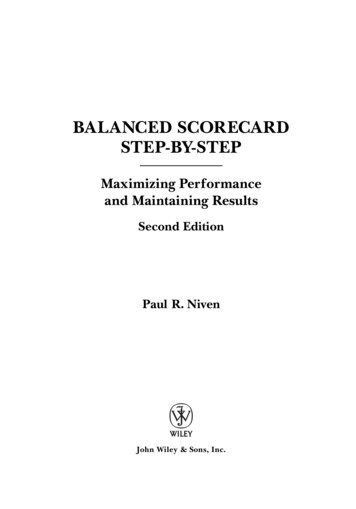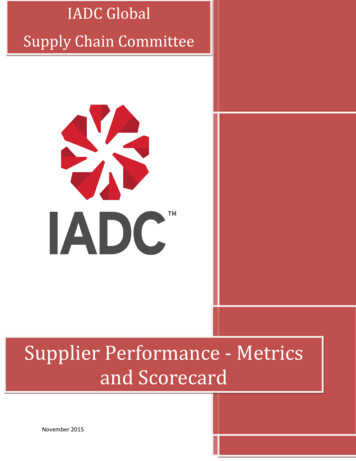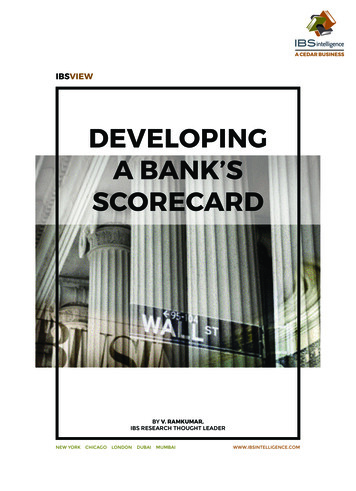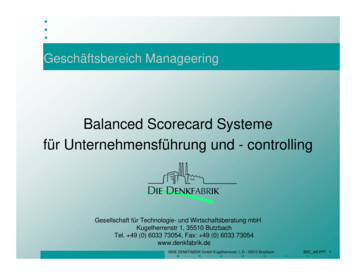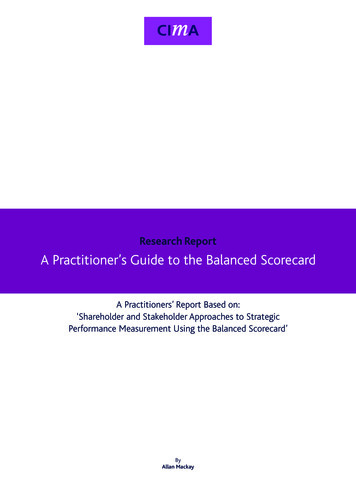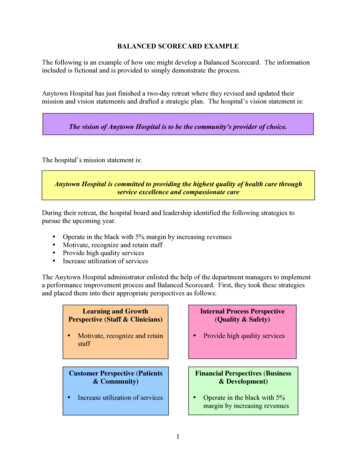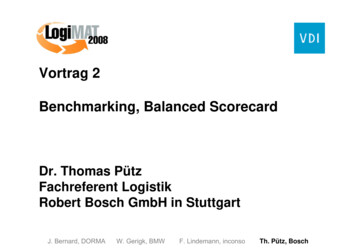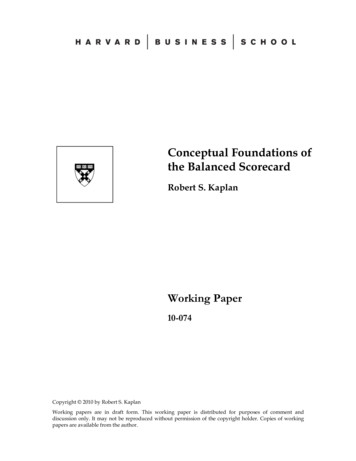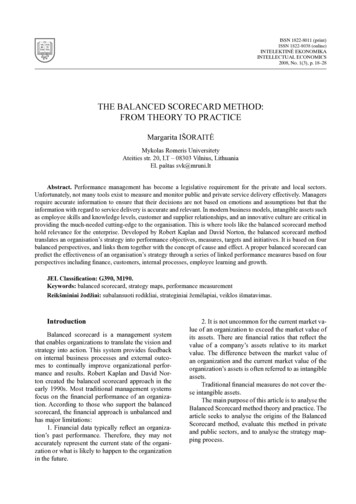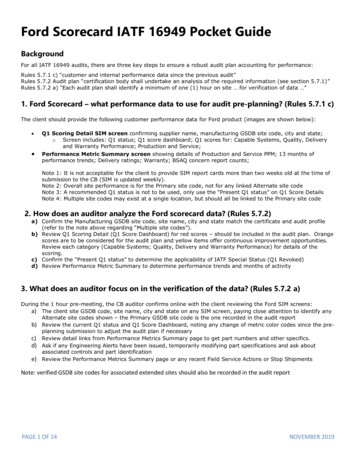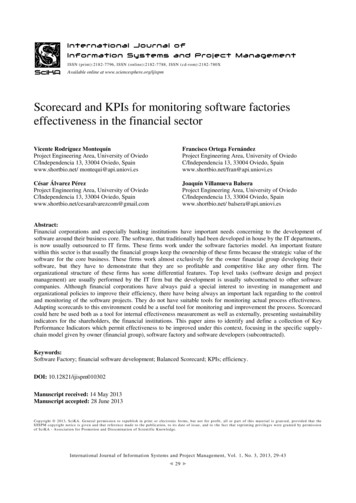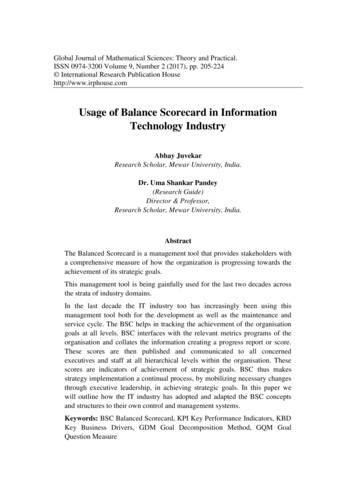
Transcription
Global Journal of Mathematical Sciences: Theory and Practical.ISSN 0974-3200 Volume 9, Number 2 (2017), pp. 205-224 International Research Publication Househttp://www.irphouse.comUsage of Balance Scorecard in InformationTechnology IndustryAbhay JuvekarResearch Scholar, Mewar University, India.Dr. Uma Shankar Pandey(Research Guide)Director & Professor,Research Scholar, Mewar University, India.AbstractThe Balanced Scorecard is a management tool that provides stakeholders witha comprehensive measure of how the organization is progressing towards theachievement of its strategic goals.This management tool is being gainfully used for the last two decades acrossthe strata of industry domains.In the last decade the IT industry too has increasingly been using thismanagement tool both for the development as well as the maintenance andservice cycle. The BSC helps in tracking the achievement of the organisationgoals at all levels. BSC interfaces with the relevant metrics programs of theorganisation and collates the information creating a progress report or score.These scores are then published and communicated to all concernedexecutives and staff at all hierarchical levels within the organisation. Thesescores are indicators of achievement of strategic goals. BSC thus makesstrategy implementation a continual process, by mobilizing necessary changesthrough executive leadership, in achieving strategic goals. In this paper wewill outline how the IT industry has adopted and adapted the BSC conceptsand structures to their own control and management systems.Keywords: BSC Balanced Scorecard, KPI Key Performance Indicators, KBDKey Business Drivers, GDM Goal Decomposition Method, GQM GoalQuestion Measure
206Abhay Juvekar and Dr. Uma Shankar Pandey1. BALANCED SCORECARD: AN INTRODUCTIONKaplan and Norton introduced the Balanced Scorecard as a way for companies tomeasure and report performance in a way that balanced: Multiple perspectives. Both leading and lagging indicators. Inward-facing measures, like productivity, and also outward-facing measures,like customer loyalty.A balanced scorecard is, “a system of linked goals, measures, targets and initiativeswhich collectively describe the strategy of an organization and how the strategy canbe achieved.”Goals are desired outcomes. The progress toward attaining a goal is gauged by one ormore measures. As with perspectives, there are causal relationships between goals. Infact, the causal relationship is defined by dependencies among goals. So, it is criticalto set measurable, strategically relevant, consistent, time bound goals. Strategicmeasures are the indicators of how a business is performing relative to its strategicgoals. Thus the measures must be relevant to the goal and strategy and be placed incontext of a target to be reached in an identified time frame.The four perspective performance measures are linked as follows: What can we learn and improve upon so as to create more value [internallearning] How can we be more productive and effective in delivery? [internal processes] How can we satisfy and even delight our customers? [external marketplace] How can we improve upon our financial ratings? [internal and externalshareholders]Each perspective must have its own table of goals and measures with targets.The balanced scorecard enables better decision making and problem solving abilitiesby providing an interrelated all round performance profile for the management.The Balanced Scorecards are used for describing a strategy in modern organizationsand for measuring the results of implementing that strategy.Nowadays, opportunities for creating value are shifting from managing tangible assetsto managing knowledge-based strategies that deploy an organization’s intangibleassets. Intangible assets have become the major sources for competitive advantage.This calls for tools that describe knowledge-based assets and the value-creatingstrategies that these assets make possible.
Usage of Balance Scorecard in Information Technology Industry207Organizations need a new kind of management system, one designed to managestrategy, not tactics. For these companies, strategy implementation requires that allbusiness units, support units and employees are aligned and linked to the strategy.Thus strategy implementation must become a continual and participative process.The Balanced Scorecard makes the difference, allowing focusing all organizationalresources on a new strategy. This new BSC management system has three distinctdimensions: Allows the company to describe and communicate its strategy in a way thatcould be understood and acted on. Acts as a ‘navigation’ aide, such that all resources and activities in theorganization are focused on and aligned towards the strategy. Provides the logic and architecture to establish new organization linkagesacross business units, shared services and teams.Features of intangible assets: Improvements in intangible assets indirectly affect financial outcomes throughchains of cause-and-effect relationships involving multiple stages. Value of intangible assets depends on organizational strategy and context. Value is potential as investments in intangible assets can only be indicative ofany realizable value. Intangible assets have to be bundled to other assets, tangible or intangible forcreating value.
208Abhay Juvekar and Dr. Uma Shankar PandeyBSC cycle for institutionalizing strategyDevelop thestrategyLearn and planto adapt thestrategyTranslatethestrategyThe BSCcycleImplement,test andmonitorAlign theorganizationPlanoperationsThe Balanced Scorecard provides a new framework to describe a strategy by linkingintangible and tangible assets in value-creating activities.2. BALANCED SCORECARD AS A MANAGEMENT TOOL WITHMULTIPLE PERSPECTIVES AND MEASURESBSC enables the organisation to have a systems based approach for seniormanagement. This approach encourages leadership growth and adoption of continualchange management for improvement. BSC allows for iterative cyclic evolution ofsystems. BSC is to be reviewed regularly to enable analysis and feedback, based ondata based information that aids operational decision-making. Analysis involvesexamining leading indicators that are evaluated to confirm accuracy of assumptionsmade in the earlier cycle. Thus BSC is a “living document” that requires regularrevision of goals, measures and initiatives enabling answers to be found for questionsas in: How are we doing? Are we measuring the right things? What initiatives do we need to get us where we want to go?
Usage of Balance Scorecard in Information Technology Industry 209Have our organizational goals changed?The systems deployed must have performance indicators that are amenable to metricanalysis and feedback scores, enabling iterative continual improvement andorganization growth.Care must be taken that the design of the systems allows the integration of systemsstrategy with organisation culture. BSC systems approach thus enables a cycle ofmanagement leadership in thinking and planning and execution and performancemonitoring.It is important to balance lagging indicators—which includes most financialmeasures—with leading indicators—areas where good performance will lead toimproved results in the future.It is also important to balance internal measures, such as cost reduction, incidentoccurrence rates, and training programs, with external measures like market share,supplier performance, and customer satisfaction.BSC can be used to focus the operations on the achievement of strategic goals. Thiscan be done by breaking down the strategic goals into goals for operations that willroll up to achieve the strategic goals.A performance measurement management system, then, is a closed loop system thatembodies situational analysis of information, corrective actions, and result evaluation.A fundamental premise of BSC is that perspectives and measures at all levels arelinked based on governing business rules. This brings in a strategic focus onmanagement controls.The four perspectives are linked in a simplistic and logical manner, as follows:High levels of competency of employees ensure that the processes will be executedefficiently and correctly. A continual cycle of process improvement leads to betterquality of delivery, timeliness of delivery and reduced costs of delivery. Continualimprovements in delivery to customers lead to greater degree of customer satisfaction.Satisfied customers lead to growth in sales and consequent profitability.Strategy mapping is a visual way to make explicit an organization’s perspectives,goals, and the relationships between them. Mapping the strategic relationships servesas a way to evaluate goals to make sure they are consistent and comprehensivelycoupled, thus enabling in implementing the strategy. In this fashion BSC for eachperspective and each hierarchical level can be cascaded through an organization, andeach level’s map can be viewed for alignment with the overall strategy map.The strategy matrix is another useful visualization and summarization tool. It displaysgoals, measures, targets, and initiatives in one table. The strategy matrix will reflect astrategic theme, so one matrix is prepared for each theme.
210Abhay Juvekar and Dr. Uma Shankar PandeyThe matrix will display the four facets by row and each row will display by columnthe following: goal, measure, target and an action plan to achieve the goal(s).BSC has adopted four perspectives of governance management. They are as follows:Perspective of Finance: Improved bottom line Increase in shareholder value Greater return on investments and capital deployed Focus on profitability and economic value gained Focus on sources of funds, utilization of funds and budgets Ratio of Sales stocks VS Production costs Effective risk management for healthy financial ratios Improve on cost structures Increase capital asset productive utilizationPerspective of Customer: Delivery on time Complete and correct (defect free) delivery Greater value for money of customer Lengthy [age of]relationship bond Strong [greater trust] relationship bond Higher satisfaction level of customer for performance and reliability More referrals from customer and consequent trade growth Increase in the addition of new customers Increase in new directions for market share growth Satisfactory customer complaint rectification tracking Lessening of customer complaints by frequency and intensityPerspective of internal systems: Higher levels of efficiency of operations
Usage of Balance Scorecard in Information Technology Industry211 Higher effectiveness of system delivery Lesser non-productive efforts Increase in timeliness of delivery Compliance with SLA requirements Controlled change management Clearer and correct requirement statements for development and management More effective communications between management and employees More effective communications between management and customers andsuppliers Effective risk management strategy Increased usage of advanced technology More information, based on data based facts, produced Better design of product and service for conformance to requirements Focus on continual process design and efficacy improvementPerspective of organisation strengths: Increase in employee competency levels Improved infrastructural and environmental support services Greater levels of employee satisfaction Higher lengths of retention of valuable employees Employees keen to learn for growth Contingency and succession plans made and deployed Greater technology and infrastructure support to employees Availability of databases and network infrastructure Employee mentoring for improvement in individual and team performance Focus on improvement of intra team communication skills and knowledgesharing Focus on development of leadership skills Integrating culture into and with individual employee behavior pattern
212Abhay Juvekar and Dr. Uma Shankar PandeyThese aspects of the four facets act as Key Performance Indicators [KPI] of KeyBusiness Drivers [KBD]BSC enables targets to be set for all measures in all the perspectives at all the levels.The target setting exercise is based on empirical data or current data, whatever isavailable. The targets will need to roll up from project team or assignment team levelsto organisation wide targets set for such measures. Strategic thinking drives tacticalplanning for conversion of goals to actionable plans .The target setting has to bebacked up with the knowledge, tools, and means to achieve that target.BSC serves the purpose of tracking and monitoring the achievement of strategicgoals. These goals at the highest level are broken down to goals at the field operationlevels and BSC helps to track and monitor and report on all the goals at all the levels.This allows the employees at all levels to be aligned with the organisation strategyand be involved in achieving strategic goals at the highest levels.The Diagram and explanatory Map and Table below are indicative of perspective wisebreakdown of strategic goals from organisation level at the top down to Business Unitlevel and further down to individual project or assignment level. The breakdown isachieved using GDMStrategy Map: Diagrammatic representation of perspective wise breakdown of goalsas per management erspectiveOperationsmanagementperspectiveThe 4facetsThe 4facetsThe 4facetsTop levelgoalsB-Unit levelgoalsOperationslevel goals
Usage of Balance Scorecard in Information Technology Industry213Strategy Matrix: Table of top down perspective wise breakdown of goalsCustomer goalsFinance goalsInternal Systems Employees goals Hierarchical levelgoalsSatisfaction withdeliveryCompetitivepricingDefect freedeliveryMinimal benchstrengthTimely ngMinimalRetaining costs2Complete testcoverage at eachphaseSufficient SkilltrainingFull ActivitycostingMinimal reworkcosts2Low Defectdensity @ phaseJIT resourceusageActivityplanningRegular Individualmentoring3 [Project orAssignment]SLA correctlyimplementedSLA terms metfirst timeRequired Peerreview conductedProductivityMinimal Cost ofResources1[Organisation]Reduced EffortMinimal2 [Business Unit]budgetsRecruitment costsEffectiveHigh level of teamchange control cohesive working3NecessaryDomainknowhowMinimal nonbillable activityWorkenvironmentsatisfaction3Algorithm designtesting ogyupgradesIncreased level ofteam bonding3SatisfactorydeliveryacceptancePlanned andmanaged releaseTimeliness ofdeliveryManaged processinterfacingoperations3Once the goals are defined, then using GQM, we can establish measures for eachgoal. Once measures are defined then targets can be set for each measure. It is theresponsibility of management to determine how the organization will achieve itsgoals. Measures are used to determine the effectiveness of strategic initiatives.Now for each perspective level BSC will trigger an iterative cyclic plan of action [seeBSC cycle above]Measures and target values chosen must be seen to relevant and practical. Measuresmust be easy to collect and the targets set should be achievable from the view of theoperations groups. Measurement data must be available, accessible and current.Communication regarding the BSC must be in a format that makes it simple to follow
214Abhay Juvekar and Dr. Uma Shankar Pandeyand understand whilst also being relevant and timely. BSC can be used manage theorganisation operations. Analysis and feedback based on the BSC reports acts as alearning board so as to enable the organisation to fine tune the governing businessrules and policies, as required. This will enable the people to understand what wehave been doing, what we are achieving and how we can now perform better andachieve more.3. DEPLOYMENT OF BSC IN IT: FEATURES, MEASURES ANDCONTROLSLike any other management initiative, introduction of BSC to the organisation mustbe accorded a status of a priority project. As in any other project, there must be a‘live’ project management plan, encompassing a detailed schedule. The project planmust detail all perspectives at all levels. The measures, targets and monitoring andcontrol action plan must be outlined in detail for all perspectives at all levels. Caremust be taken that are no intra-perspective and time bound conflicts in the measuresand controls defined. Measurement and controls must be prioritized so that criticalmeasures are not missed. Measures must be agreed upon by operational personnel andmust be seen as a means to achieving strategic goal. Measurement exercise must becost effective. Budgets and cost structures must be defined for the managementcontrol activities using the BSC. Communication to all personnel associated with theplan at all levels must be sufficient as to outline the roles and responsibilities for eachindividual person. Communications must also include periodic reporting onachievements, both recent and to-date. Communications must be made in an easy-tofollow manner such that employees at the lower levels must fully comprehend. Thishelps to keep the personnel focused and motivated. Feedback also keeps the BSC as a‘live’ management tool that can be adjusted and tuned to be more useful and moreinformative.The BSC project core team must be competent and be responsible for creating thestrategy map, the associated goals and the relevant scorecard. The project teammembers must be trained to works with other employees to develop measuressupporting strategic goals. This avoids having differences and issues from croppingup during implementation. The project team management must coordinate closelywith the top leadership to plan and implement the Balanced Scorecard. The decisionon how to implement the BSC must be made by the core project team. BSC can beimplemented by one of the two popular routes; as pilot project or on a full scale bigbang approach. Depending on the nature of the IT business and the organisationculture one of these two routes can be chosen.BSC will thus be seen as a management tool that tells us how we have performed andwhat we have achieved and how much have we contributed towards the achievement
Usage of Balance Scorecard in Information Technology Industry215of the organisation corporate level goals and eventual vision. Thus a majority of theorganisation workforce can be involved from designing to performing and scoring asper the BSC framework. This will enable enthusiastic participation from people of allfunctions in an organisation in adopting BSC as an integrated part of their regularwork-life. People will be willing and wanting to work with and help the topmanagement adopt BSC and make the adoption successful and the utility as anessential part of governing. The workforce must be extensively trained and be wellinformed about the entire mission of adopting BSC as a management tool forachieving organisation goals. All functions of the organisation must participate in thisprocess of adoption of BSC through their representatives.BSC can be gainfully used to highlight the contribution of indirect and supportfunctions so that the staff within those functions can realize how valuable they are tothe organisation in achieving the top level goals. This will also help justifying thebudgets and expenses of these functions.Goals chosen can be both short term and long term where short term would typicallymean between 6 or 8 quarters and long term could mean between 20 or 28 quarters.Organisations must define the period for short, mid and long terms. Depending on theperiod for the goals defined, the periodicity of BSC reporting can be decided.Consequently, depending on the periodicity of BSC reporting, the periodicity ofmeasurement collection and collation can be decided. This will also depend on thenature of the measure itself. The methods chosen for measurement collection must bepracti
Usage of Balance Scorecard in Information Technology Industry 207 Organizations need a new kind of management system, one designed to manage strategy, not tactics. For these companies, strategy impleme
